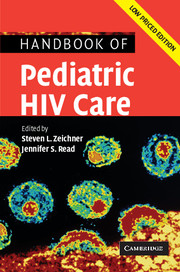31 results
List of contributors
-
- Book:
- Handbook of Pediatric HIV Care
- Published online:
- 23 December 2009
- Print publication:
- 04 May 2006, pp xi-xv
-
- Chapter
- Export citation
Index
-
- Book:
- Handbook of Pediatric HIV Care
- Published online:
- 23 December 2009
- Print publication:
- 04 May 2006, pp 844-871
-
- Chapter
- Export citation
Part VI - Medical, social, and legal issues
-
-
- Book:
- Handbook of Pediatric HIV Care
- Published online:
- 23 December 2009
- Print publication:
- 04 May 2006, pp 757-758
-
- Chapter
- Export citation
Preface
-
-
- Book:
- Handbook of Pediatric HIV Care
- Published online:
- 23 December 2009
- Print publication:
- 04 May 2006, pp xxix-xxx
-
- Chapter
- Export citation
Part IV - Clinical manifestations of HIV infection in children
-
-
- Book:
- Handbook of Pediatric HIV Care
- Published online:
- 23 December 2009
- Print publication:
- 04 May 2006, pp 471-472
-
- Chapter
- Export citation
Part I - Scientific basis of pediatric HIV care
-
-
- Book:
- Handbook of Pediatric HIV Care
- Published online:
- 23 December 2009
- Print publication:
- 04 May 2006, pp 1-2
-
- Chapter
- Export citation
List of abbreviations
-
- Book:
- Handbook of Pediatric HIV Care
- Published online:
- 23 December 2009
- Print publication:
- 04 May 2006, pp xvi-xxvi
-
- Chapter
- Export citation
Part V - Infectious problems in pediatric HIV disease
-
-
- Book:
- Handbook of Pediatric HIV Care
- Published online:
- 23 December 2009
- Print publication:
- 04 May 2006, pp 651-652
-
- Chapter
- Export citation

Handbook of Pediatric HIV Care
-
- Published online:
- 23 December 2009
- Print publication:
- 04 May 2006
Frontmatter
-
- Book:
- Handbook of Pediatric HIV Care
- Published online:
- 23 December 2009
- Print publication:
- 04 May 2006, pp i-vi
-
- Chapter
- Export citation
1 - The scientific basis of pediatric HIV care
-
-
- Book:
- Handbook of Pediatric HIV Care
- Published online:
- 23 December 2009
- Print publication:
- 04 May 2006, pp 3-77
-
- Chapter
- Export citation
Contents
-
- Book:
- Handbook of Pediatric HIV Care
- Published online:
- 23 December 2009
- Print publication:
- 04 May 2006, pp vii-x
-
- Chapter
- Export citation
Part III - Antiretroviral therapy
-
-
- Book:
- Handbook of Pediatric HIV Care
- Published online:
- 23 December 2009
- Print publication:
- 04 May 2006, pp 333-334
-
- Chapter
- Export citation
Part II - General issues in the care of pediatric HIV patients
-
-
- Book:
- Handbook of Pediatric HIV Care
- Published online:
- 23 December 2009
- Print publication:
- 04 May 2006, pp 97-98
-
- Chapter
- Export citation
Introduction
-
-
- Book:
- Textbook of Pediatric HIV Care
- Published online:
- 03 February 2010
- Print publication:
- 28 April 2005, pp 1-2
-
- Chapter
- Export citation
Plate section
-
- Book:
- Textbook of Pediatric HIV Care
- Published online:
- 03 February 2010
- Print publication:
- 28 April 2005, pp -
-
- Chapter
- Export citation
Part VI - Medical, social, and legal issues
-
-
- Book:
- Textbook of Pediatric HIV Care
- Published online:
- 03 February 2010
- Print publication:
- 28 April 2005, pp 633-634
-
- Chapter
- Export citation
Frontmatter
-
- Book:
- Textbook of Pediatric HIV Care
- Published online:
- 03 February 2010
- Print publication:
- 28 April 2005, pp i-vi
-
- Chapter
- Export citation
Part III - Antiretroviral therapy
-
-
- Book:
- Textbook of Pediatric HIV Care
- Published online:
- 03 February 2010
- Print publication:
- 28 April 2005, pp 285-286
-
- Chapter
- Export citation
Part IV - Clinical manifestations of HIV infection in children
-
-
- Book:
- Textbook of Pediatric HIV Care
- Published online:
- 03 February 2010
- Print publication:
- 28 April 2005, pp 411-412
-
- Chapter
- Export citation



